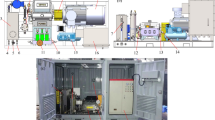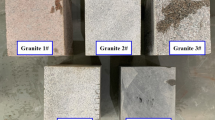Abstract
High-pressure pure water jet has been widely used in breaking soft rocks and medium–hard rocks, but its research on cutting hard rocks is very limited. The cutting depth, as the most important index for evaluating the effectiveness of rock breaking by water jet, is difficult to be predicted accurately because of numerous influencing factors. This article aims to establish a concise and universal prediction model for the cutting depth of hard rock, including all variables that affect the cutting depth. Firstly, four types of granite and sandstone, which are difficult to break in engineering, are selected to investigate their cutting depth under the action of high-pressure continuous water jets. The rock physico-mechanical parameter that has the highest correlation with the cutting depth is found to be the shear modulus through tests. In order to reasonably evaluate the energy utilization rate of cutting depth of rock by water jet, the concept of cutting depth energy index (CDEI) is proposed. The jet pressure corresponding to the maximum value of CDEI is approximately 40–60% of the rock compressive strength. The idea of “moderate nozzle diameter, high traverse speed, multiple cuts” is put forward for cutting hard rock more efficiently using high-pressure water jet. Then, a new prediction model of cutting depth for high-pressure water jet cutting hard rock is established using similarity theory and dimensional analysis method, and the accuracy and reliability of the model are verified through experimental testing. The results of the study can help to improve the breakage efficiency of hard rock, and at the same time, provide a theoretical basis for the rational selection of high-pressure water jet parameters.
Highlights
-
The concept of cutting depth energy index (CDEI) of rock subjected to water jet is proposed.
-
The most effective cutting technology method for cutting hard rock by water jet is proposed taking into account the cutting effect and specific energy consumption.
-
A new prediction model of cutting depth for high-pressure water jet cutting hard rock was established using similarity theory and dimensional analysis method
-
The primary variables affecting the cutting depth of hard rock are the jet pressure and the shear modulus of the rock





















Similar content being viewed by others
References
Averin E (2017) Universal method for the prediction of abrasive waterjet performance in mining. Engineering-Prc 3:888–891
Aydin G, Karakurt I, Aydiner K (2011) An investigation on surface roughness of granite machined by abrasive waterjet. Bull Mater Sci 34:985–992
Aydin G, Karakurt I, Aydiner K (2013) Prediction of the cut depth of granitic rocks machined by abrasive waterjet (AWJ). Rock Mech Rock Eng 46:1223–1235
Berberan-Santos MN, Pogliani L (1999) Two alternative derivations of Bridgman’s theorem. J Math Chem 26:255–261
Buckingham E (1914) On Physically Similar Systems; Illustrations of the Use of Dimensional Equations. Phys Rev 4:345–376
Cheng JL, Wang YX, Wang LG, Li YH, Hu B, Jiang, Z.H., 2021. Penetration behaviour of TBM disc cutter assisted by vertical precutting free surfaces at various depths and confining pressures. Arch Civil Mech Eng 21
Crow SC (1973) A theory of hydraulic rock cutting. Int J Rock Mech Min Sci Geomech Abstracts 10:567–584
de Martins RA (1981) The origin of dimensional analysis. J Franklin Inst 311:331–337
Dehkhoda S, Bourne NK (2014) Production of a high-velocity water slug using an impacting technique. Rev Sci Instrum 85
Dehkhoda S, Hood M (2014) The internal failure of rock samples subjected to pulsed water jet impacts. Int J Rock Mech Min Sci 66:91–96
Enever JR, Tooley SM (1985) Laboratory assessment of the hydraulic cuttability of an Australian black coal. Aust Inst Min Metall Bull Proc 290
Engin IC (2012) A correlation for predicting the abrasive water jet cutting depth for natural stones. S Afr J Sci 108:1–11
Ge Z, Shangguan J, Zhou Z, Li Z, Liu L, Chen C, Shao C (2023) Investigation of fracture damage and breaking energy consumption of hard rock repeatedly cut by abrasive water jet. Rock Mech Rock Eng 56:3215–3230
Gryc R, Hlavac LM, Mikolas M, Sancer J, Danek T (2014) Correlation of pure and abrasive water jet cutting of rocks. Int J Rock Mech Min Sci 65:149–152
Hagan P (1992) The cuttability of rock using a high pressure water jet, Western Australia conference on mining geomechanics. Proceedings of the Western Australian conference on mining geomechanics, pp. 8–10
Hashish M (1984) A modeling study of metal cutting with abrasive waterjets. J Eng Mater Technol 106:88–100
Hashish M, duPlessis MP (1978) Theoretical and experimental investigation of continuous jet penetration of solids. J Manuf Sci Eng 1:88–94
Jiang T, Huang Z, Li J, Li H (2021) Effect of parameters on threshold pressure of sandstone tested by water jet. Int J Rock Mech Min Sci 139
Jiang YL, Zeng JJ, Xu CJ, Xiong FY, Pan YC, Chen XS, Lei ZX (2022) Experimental study on TBM cutter penetration damage process of highly abrasive hard rock pre-cut by high-pressure water jet. B Eng Geol Environ 81
Karakurt I, Aydin G, Aydiner K (2012) An experimental study on the depth of cut of granite in abrasive waterjet cutting. Mater Manuf Processes 27:538–544
Kim JG, Song JJ (2015) Abrasive water jet cutting methods for reducing blast-induced ground vibration in tunnel excavation. Int J Rock Mech Min Sci 75:147–158
Li D (2016) A new technology for the drilling of long boreholes for gas drainage in a soft coal seam. J Pet Sci Eng 137:107–112
Li BA, Zhang B, Hu MM, Liu B, Cao WZ, Xu B (2022a) Full-scale linear cutting tests to study the influence of pre-groove depth on rock-cutting performance by TBM disc cutter. Tunn Undergr Space Technol 122:104366
Li HS, Liu SY, Zhou FY, Jiang HX, Wang FC, Guo CW (2022b) Experimental investigation on concrete rock breaking performance of self-excited oscillation pulsed waterjet. Eng Fracture Mech 268:108502
Liu X, Liu S, Ji H (2015) Numerical research on rock breaking performance of water jet based on SPH. Powder Technol 286:181–192
Liu S, Zhou F, Li H, Chen Y, Wang F, Guo C (2020) Experimental investigation of hard rock breaking using a conical pick assisted by abrasive water jet. Rock Mech Rock Eng 53:4221–4230
Liu F, Wang Y, Song G (2023) Damage evolution law and failure mechanism of rock impacted by high-pressure water jet under in-situ stress condition. Sci Prog 106
Llanto JM, Tolouei-Rad M, Vafadar A, Aamir M (2021) Recent progress trend on abrasive waterjet cutting of metallic materials: a review. Appl Sci-Basel 11:3344
Lu Y, Tang J, Ge Z, Xia B, Liu Y (2013) Hard rock drilling technique with abrasive water jet assistance. Int J Rock Mech Min Sci 60:47–56
Lu Y, Huang F, Liu X, Ao X (2015) On the failure pattern of sandstone impacted by high-velocity water jet. Int J Impact Eng 76:67–74
Mendoza C (1994) A theorem for Rayleigh’s method of dimensional analysis and its proof. Mech Res Commun 21:103–107
Mostofa MG, Kil KY, Hwan AJ (2010) Computational fluid analysis of abrasive waterjet cutting head. J Mech Sci Technol 24:249–252
Oh TM, Cho GC (2016) Rock cutting depth model based on kinetic energy of abrasive waterjet. Rock Mech Rock Eng 49:1059–1072
Polyakov A, Zhabin A, Averin E, Polyakov A (2019) Generalized equation for calculating rock cutting efficiency by pulsed water jets. J Rock Mech Geotech Eng 11:867–873
Powell JH, Simpson SP (1969) Theoretical study of the mechanical effects of water jets impinging on a semi-infinite elastic solid. Int J Rock Mech Min Sci Geomech Abstracts 6(4):353–364
Rehbinder G (1977) Slot cutting in rock with a high speed water jet. Int J Rock Mech Min Sci Geomech Abstracts 14:229–234
Rehbinder G (1978) Measurement of the average pore velocity of water flowing through a rock specimen. Rock Mech 11:19–28
Rehbinder G (1980) A theory about cutting rock with a water jet. Rock Mech 12:247–257
Sedov LI, Friedman M, Holt M, Cole JD (1982) Similarity and dimensional methods in mechanics. J Appl Mech 28:159
Srivastava M, Hloch S, Tripathi R, Kozak D, Chattopadhyaya S, Dixit AR, Foldyna J, Hvizdos P, Fides M, Adamcik P (2018) Ultrasonically generated pulsed water jet peening of austenitic stainless-steel surfaces. J Manuf Process 32:455–468
Stoxreiter T, Martin A, Teza D, Galler R (2018) Hard rock cutting with high pressure jets in various ambient pressure regimes. Int J Rock Mech Min Sci 108:179–188
Tripathi R, Hloch S, Chattopadhyaya S, Klichova D, Scucka J, Das AK (2020) Application of the pulsating and continous water jet for granite erosion. Int J Rock Mech Min Sci 126
Wang J (2009) A new model for predicting the depth of cut in abrasive waterjet contouring of alumina ceramics. J Mater Process Technol 209:2314–2320
Wang G, Qiao SF, Wang G, Jiang H, Singh J (2022) Cutting depth of pile materials subjected to the abrasive waterjet and its prediction model. Tunn Undergr Space Technol 124:104473
Xu H, Gong Q, Zhou X, Yang F, Han B (2023) Influence of the assisted kerf depth on cracks pattern and cutting performance of TBM cutter. Int J Rock Mech Min Sci 170
Yang Z, Dou L, Liu C, Xu M, Lei Z, Yao Y (2016) Application of high-pressure water jet technology and the theory of rock burst control in roadway. Int J Min Sci Technol 26:929–935
Zhang JL, Yang FW, Cao ZG, Xia YM, Li YC (2022) In situ experimental study on TBM excavation with high-pressure water-jet-assisted rock breaking. J Central South Univ 29:4066–4077
Acknowledgements
This research work was financially supported by the National Key Research and Development Program (Grant no. 2022YFC3005902), the Fundamental Research Funds for the Central Universities (Grant no.2021GJZPY15), the Graduate Innovation Program of China University of Mining and Technology (Grant no.2023WLKXJ189), the Postgraduate Research & Practice Innovation Program of Jiangsu Province (Grant no. KYCX23_2748).
Author information
Authors and Affiliations
Corresponding author
Ethics declarations
Conflict of Interest
The authors declare that there are no conflicts of interest regarding the publication of this paper.
Additional information
Publisher's Note
Springer Nature remains neutral with regard to jurisdictional claims in published maps and institutional affiliations.
Rights and permissions
Springer Nature or its licensor (e.g. a society or other partner) holds exclusive rights to this article under a publishing agreement with the author(s) or other rightsholder(s); author self-archiving of the accepted manuscript version of this article is solely governed by the terms of such publishing agreement and applicable law.
About this article
Cite this article
Liu, F., Wang, Y., Huang, X. et al. A New Prediction Model for Cutting Depth of Hard Rock Using High-Pressure Water Jets. Rock Mech Rock Eng (2024). https://doi.org/10.1007/s00603-024-03919-1
Received:
Accepted:
Published:
DOI: https://doi.org/10.1007/s00603-024-03919-1




